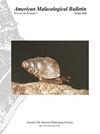双壳目:蓝灯子(Lampsilis cardidium)的种群遗传分析揭示了冰期后进入五大湖流域的多条殖民路线
IF 0.4
4区 生物学
Q4 MARINE & FRESHWATER BIOLOGY
引用次数: 8
摘要
淡水贻贝(Unionida目)是北美淡水生态系统中历史上丰富的组成部分,但也是最危险的动物群之一。了解潜在的遗传结构及其与历史地理变化的关系对于制定有效的保护策略至关重要。在这里,我们分析了五大湖和密西西比河流域淡水贻贝Lampsilis cardium(Rafinesque,1820)的线粒体基因片段(COI)和6个微卫星位点,以评估系统发育结构。线粒体系统发育显示出地理结构,其中一个不同的分支仅在Maumee河和Wabash河中发现。使用COI序列创建的系统发育表明推定的L.cardium的两个不同分支之间存在差异(未校正的p距离=5.22%)。微卫星分析的结果表明,两个遗传上不同的种群对应于至少两个冰川避难所,与该地区其他一些淡水贻贝的遗传结构相似,并且与mtDNA数据集的结果基本一致。从其他已发表的研究中获得了三个来自推定的L.ovata(Say,1817)的COI序列,并包括系统发育分析,这些序列使本研究中产生的推定的L.cardium序列成为非单系。这表明,需要做更多的工作来确定L.cardium和L.ovata是代表两个不同的物种还是代表两个截然不同的种群。尽管两个单系支中的COI单倍型高度不同,但核微卫星标记未能检测到这两个支中个体在其共同出现的区域内等位基因频率的差异(FST=0.004)。这些数据有助于统一群的保护策略,为维持自然遗传结构的最佳实践提供指导。本文章由计算机程序翻译,如有差异,请以英文原文为准。
Population Genetic Analyses of Lampsilis cardium (Bivalvia: Unionida) Reveal Multiple Post–Glacial Colonization Routes into the Great Lakes Drainage
Freshwater mussels (order Unionida) are a historically abundant component of North American freshwater ecosystems, yet are among the most imperiled faunal groups. Understanding the underlying genetic structure and how it relates to historical geographic changes is critical for development of effective conservation strategies. Here we analyze mitochondrial gene fragments (COI) and 6 microsatellite loci of the freshwater mussel Lampsilis cardium (Rafinesque, 1820) in the Great Lakes and Mississippi River drainages to assess phylogenetic structure. The mitochondrial phylogeny shows geographic structure, with one divergent clade found exclusively in the Maumee and Wabash River. Phylogenies created using the COI sequences indicate divergence between two distinct clades of putative L. cardium (uncorrected p distance = 5.22%). Results from the microsatellite analyses suggest two genetically distinct populations corresponding to at least two glacial refugia, similar to the genetic structure observed for some other freshwater mussels in the region and are largely consistent to the results of mtDNA dataset. Three COI sequences from putative L. ovata (Say, 1817) were obtained from other published studies and included the phylogenetic analysis, these rendered the sequences from putative L. cardium generated in this study non–monophyletic. This suggests that more work is needed to determine whether L. cardium and L. ovata represent two distinct species or represent two divergent populations. Despite the highly divergent COI haplotypes in two monophyletic clades, nuclear microsatellite markers failed to detect differences in allele frequencies between individuals from these two clades in regions where they co–occur (FST = 0.004). These data aid in conservation strategies for unionids, providing guidance of best practices for maintaining natural genetic structure.
求助全文
通过发布文献求助,成功后即可免费获取论文全文。
去求助
来源期刊
CiteScore
1.00
自引率
40.00%
发文量
1
审稿时长
>12 weeks
期刊介绍:
The American Malacological Bulletin serves as an outlet for reporting notable contributions in malacological research. Manuscripts concerning any aspect of original, unpublished research,important short reports, and detailed reviews dealing with molluscs will be considered for publication. Recent issues have included AMS symposia, independent papers, research notes,and book reviews. All published research articles in this journal have undergone rigorous peer review, based on initial editor screening and anonymous reviewing by independent expertreferees. AMS symposium papers have undergone peer review by symposium organizer, symposium participants, and independent referees.

 求助内容:
求助内容: 应助结果提醒方式:
应助结果提醒方式:


